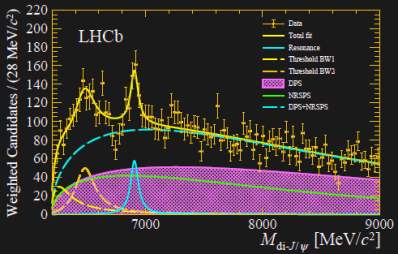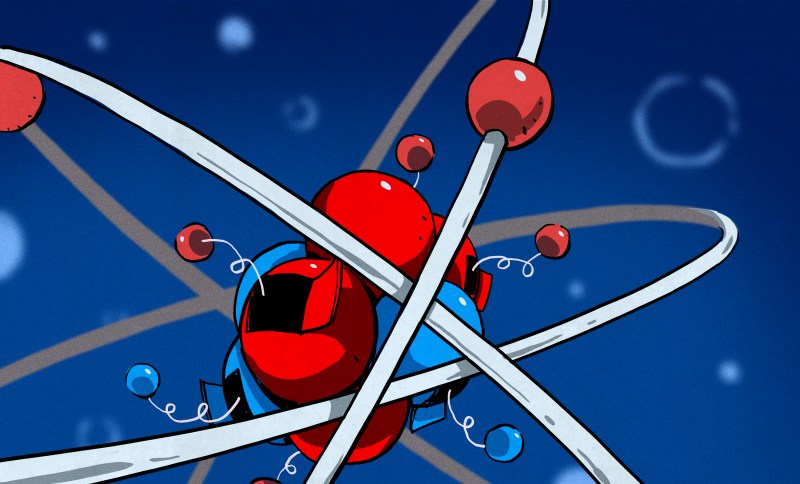The holy grail of every particle physics experiment is the discovery of a new particle. Finding a new constituent of matter may earn you eternal glory within the history of physics. Unfortunately, since the last missing piece of the Standard Model, the Higgs boson, was discovered in 2012, and with still no clue about the nature of dark matter and dark energy, there is not much hope to stumble upon a new fundamental building block of matter any time soon.
Luckily, this is not true for composite particles, especially the strange world of quark matter still yields some potential for new discoveries. The latest of such was the observation of a new tetraquark by the LHCb experiment. But what the hell is a quark anyway and why is it named after a German dairy product?
The Proton Is Not Just a Dot
Up until the 1950s, it was believed that subatomic particles such as the neutron and proton are elementary, point-like particles with no inner structure. In the following decade, the progress made by accelerator experiments led to the discovery of an entire zoo of new particles. This sudden “particle explosion” irritated physicists who believed in the beauty of simplicity. Wolfgang Pauli exclaimed that had he foreseen this, he would have become a botanist instead. US physicist Willis Lamb suggested that the discovery of a new particle now ought to be punished with $10,000 fine instead of a Nobel Prize.
In 1964, Murray Gell-Mann and George Zweig independently came up with a model proposing that these new particles are not elementary but instead composed of a combination of new fundamental particles called quarks. The name was coined by Gell-Mann who pronounced it “kwork” and later adopted the spelling from the following cryptic line in James Joyce’s book Finnegans Wake.
Three quarks for Muster Mark!
Sure he has not got much of a bark
And sure any he has it’s all beside the mark.
While Gell-Mann interpreted the line as a call for drinks (“Three quarts for Mister…”) it is unclear what James Joyce really meant. Some think it represents the cry of a seagull while others attribute it to the German word for a kind of cottage cheese.
Definitive proof for the existence of quarks came in 1968 when experiments at the Stanford Linear Accelerator Center showed that the proton is not a point-like particle but instead contains some inner structure. Still, people only recognized later that what they observed were in fact quarks.
A Quark Comes Rarely Alone

There are six different kinds of quarks (up, down, top, bottom, strange, charm) that have different masses and charges. For every quark there is also an antiparticle with the same mass but opposite charge. The proton, for example, consists of two up quarks (u) with charge +2/3 and one down quark (d) with charge -1/3, while a neutron consists of two down quarks and one up quark.
Like the electric force that acts on charged particles, each quark contains a color charge blue, green, or red, which makes it susceptible to the strong force. In nature, one can only observe color-neutral particles that consist either of three quarks with different colors (called baryons), or a quark-antiquark pair (called mesons).
The fact that one cannot produce isolated quarks is known as confinement. It can be understood as a peculiarity of the strong force that behaves similar to a rubber band. When trying to separate two quarks it becomes more and more difficult with increasing distance so that at some point it is energetically more favorable to create another quark-antiquark pair.
Tetraquarks and Pentaquarks

Credit: LHCb collaboration
Baryons and mesons are not the only possibilities to combine quarks in a color-neutral way. A tetraquark is also viable, being a combination of four quarks qqqq, where q and q respectively refer to a quark and antiquark. A pentaquark qqqqq may even exist.
To search for penta- and tetraquarks one smashes together electrons or protons in an accelerator and analyses the particles produced in the collisions. Since such exotic particles have extremely short lifetimes, they cannot be directly observed in a detector. Instead one plots the number of recorded events vs. the so-called invariant mass, calculated from the energy and momentum of the final decay products. In this plot, a short-lived intermediate particle shows up as a narrow resonance peak. The position of the peak equals the mass of the particle while the width is inversely proportional to its lifetime.
The first indication for the existence of a tetraquark came in 2003 from the BELLE experiment in Japan. In the same year, another Japanese experiment called SLEP maybe saw a pentaquark. In the meantime, several penta- and tetraquarks have been unambiguously discovered. At the forefront of these discoveries was the LHCb experiment which confirmed the existence of a tetraquark in 2014 and one year later also discovered a pentaquark. The tetraquark discovered recently by LHCb is special because it consists of two charm quarks and two charm antiquarks cccc. All other tetraquarks observed so far have at most two heavy quarks and none of them is made of more than two quarks of the same type.
Why Do We Even Care?
You may wonder why people go through the effort of hunting for these exotic particles. As with most particle physics experiments, it is all about a better understanding of the fundamental forces of nature, in this case, the strong force described by quantum chromodynamics (QCD). Calculating the properties of bound quarks is fairly complicated and so the measurement of these exotic particles helps to test different theoretical models. For example, it is unclear if all quarks in a tetra- and pentaquark are tightly bound together or if they form a molecule-like, loosely bound combination of baryons and mesons. Discovering more of these particles and measuring their properties could help to resolve this question.
















Thank you for this fine article which, if re-read and re-read a few more times might well update and improve my (very) limited acquaintance with modern particle physics, College was a long, long time ago but the physics course did mention quarks, however us engineers were not required to understand anything about them.
On the other hand a fine of $10,000 for Hackaday articles on coloured quarks would save me a lot of work :) .
Might have to once we figure out FTL.
“with still no clue about the nature of dark matter and dark energy”
“with still no proof of the existence of dark matter and dark energy”
FIFY
The alternative is even worse.
Imagine pointing to different places and asking what 1+1 equals in those places. It’s 2, except in some places where it isn’t.
Your explanation boils down to “of course it does!” with no further details. You must be smart enough to realize such a lack of explanation isn’t going to be taken seriously.
The question isn’t “is 1+1=3 there?”, because that is proven fact. The question is “why?”
If you don’t have an answer, that’s fine. But knocking down the people actually letting us correctly predict where 1+1=2 and 1+1=3 are doing far far more to try and find an answer to the “why” than your trying to convince anyone our observations are not being observed.
If you’re addressing me, I provided no “explanation”, simply pointed out a lack of proof of existence. Add to that a lack of proof of existence of an explanation posited by me.
Brevity!
There’s some mass out there keeping galaxies from spinning apart.
If you have a simpler explanation than dark matter, and experimental evidence to support it, there’s a nobel prize waiting for you.
You’re getting ahead of yourself. Observations don’t agree with what theory predicts. That’s all. Pointing out the bleeding obvious is hardly Nobel Prize-worthy. Saying “there must be dark matter and dark energy” is a bridge too far. The burden of providing experimental evidence is not mine, rather it belongs to those who assert the existence of dark matter and dark energy. No charge, and you’re welcome.
Hey, I know! It’s the luminiferous ether! Problem solved.
Old Guy, you must shave daily with Occam’s Razor.
I like it.
Glued in place with Space Glue™ Good enough for galaxies, and astronauts who just can’t keep it together.
i think i read something about a theoretical hexaquark being a dark matter candidate. key word theoretical. thats why we build colliders.
Saying “there’s no proof of the existence of dark matter” is like saying “there’s no proof of the existence of matter.” What’s matter anyway? Made up of atoms, made up of leptons/baryons, made up of superstrings. Wait, no proof for superstrings! So no proof of matter. We don’t know what dark matter *is*, but it certainly *exists*.
The idea of dark matter is from the late 1800s, when people looked at velocity dispersions of stars. They realized there must be more “stuff” causing gravity than is visible, and called “non visible stuff” dark matter. Didn’t have to be non-Standard Model stuff. Just not visible.
That same amount of stuff explained galaxy rotation curves, and cluster velocities. And in the early 2000s, precision CMB studies showed that *even before stars formed, and when the universe was very small* there was still too much “stuff” making the universe clump and not glowing.
Even if you try to modify gravity to explain all this, you’ll end up with something that’s still representable as dark matter, just with different kinematics. There’s no proof for a *particle* explanation of dark matter, but there’s plenty of proof for “stuff that causes extra gravity and doesn’t glow.”
Oh dude. Such a stupid stupid argument. Direct perception tells us that matter exists. As you admit, there is no proof that superstrings exist, yet you absurdly assert that matter is composed of superstrings. Then you go on to blather what you consider to be an argument for Dark Matter but at the end of the day Sir, you sound like an idiot who does not know how to reason but loves loves loves argument by assertion. “We don’t know what dark matter ‘is’, but it certainly ‘exists’.” Throw in Santa Claus and the Easter Bunny while you’re at it.
Observations don’t agree with theory. That’s ALL we know.
Yes, and your assertion that there’s no “proof” for dark matter is a similarly absurd statement. It’s a name for a collection of observations. It’s not a “thing.”
“Direct perception tells us that matter exists.”
No it doesn’t! All I have is observations that don’t agree with my theory that there’s no screen in front of me.
You know what the real definition of matter is in physics? Something that takes up volume and has nonzero mass. That’s it. That’s matter. Not molecules. Not atoms. Not protons, or electrons. Something that takes up space and has mass. That’s it. So technically if you want to be pedantic, if someone says “matter is made of particles” you can come along and say “there’s no proof of that! matter is just something that takes up space and has mass!”
Likewise, “dark matter” is a substance which creates gravity and does not interact strongly with light, and exists with about 20-25% of the critical energy of the universe, dominating the kinematics of galaxies and galactic clusters. That’s it. There’s your definition.
Now guess what? Direct perception tells us that dark matter exists, because we can watch the motion of galaxies, and see that their motion is dominated by something that doesn’t interact strongly with light. We can even *image* dark matter using lensing, as seen in the Bullet Cluster.
Matter is the name we give “stuff” that we observe taking up space. Dark matter is the name we give “stuff” that we observe dominating the motions of stars/galaxies/clusters.
Let me try to be clearer so you can understand: even if you tried to explain the observations that the gravity of dark matter is needed to explain by screwing around and modifying gravity, or general relativity, *you just end up with a new field/parameter/substance that you can call dark matter.*
Literally the only way you can get around this is if the current math behind galaxy models, galaxy cluster models, velocity dispersions, lensing, *and* CMB harmonics are *all* just screwed up, because they’re *all* explained relatively well by an equal amount of gravity from dark matter.
Otherwise, you need some new physics. Doesn’t matter what that new physics is. Whatever that new physics is, it’s dark matter.
There was article in Scientific American way back when on quarks and analogous relation to the Rubik’s cube back in the 80s. Always found particle physics fascinating. Who knows, maybe it will help bring about a super-conducting room-temp material or something….
Thinks for a brief update on the subject!
Yes, and a practical warp drive. And probably a horrible bomb or some sort of destructive device too… Let’s hope we are past that once we figure it all out.
>why is it named after a German dairy product?
The dairy product was named after the packaging, which comes from a Swedish company Tetra Pak. These were all called “tetra” and came with different beverages in different countries. In Germany and Italy you had milk tetras, in other countries you had orange juice tetras… etc.
https://i.pinimg.com/originals/9c/d1/7d/9cd17d73ef3110170fded5c5b8175bb9.jpg
The point is that the carton is made from a continuous waxed cardboard tube, and it has only two heat-sealed seams which are offset 90 degrees so it forms a pyramid juice box with four corners. It’s exceedingly simple to manufacture, although not the most efficient in terms of material use, but it does stack nicely.
I thought they were just using standard organic chemistry nomenclature: mono-1 di-2 tri-3 tetra-4 penta-5 hexa-6 hepta-7 octa-8 nona-9 deca-10.
Could be both I guess.
How did you go all round that and not mention it’s a Tetrahedron, meaning 4 faced.
Does the up quark contain and shield the energy of the charm and top quarks? What evidence is there either way?